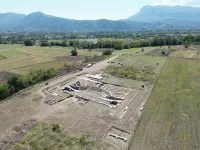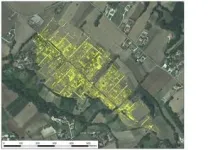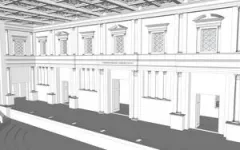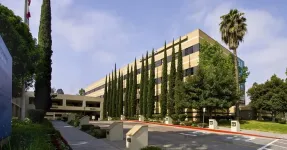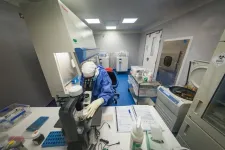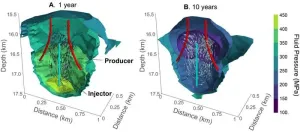(Press-News.org) UNDER STRICT EMBARGO UNTIL 00:01 AM (UK TIME) ON TUESDAY 12TH DECEMBER 2023
A rare roofed theatre, markets, warehouses, a river port and other startling discoveries made by a Cambridge-led team of archaeologists challenge major assumptions about the decline of Roman Italy.
New findings from Interamna Lirenas, traditionally written off as a failed backwater in Central Italy, change our understanding of Roman history, its excavators believe.
Their thirteen-year study – published today in the edited volume Roman Urbanism in Italy – shows that the town in Southern Lazio continued to thrive well into the 3rd century AD, bucking what is normally considered Italy’s general state of decline in this period.
The team’s pottery analysis indicates that the town’s decline began around 300 years later than previously assumed, while a systematic geophysical survey has produced an astonishingly detailed image of the entire town’s layout, highlighting a wide range of impressive urban features.
“We started with a site so unpromising that no one had ever tried to excavate it – that’s very rare in Italy,” said Dr Alessandro Launaro, the study’s author and Interamna Lirenas Project lead at the University of Cambridge’s Classics Faculty.
“There was nothing on the surface, no visible evidence of buildings, just bits of broken pottery. But what we discovered wasn’t a backwater, far from it. We found a thriving town adapting to every challenge thrown at it for 900 years.”
“We’re not saying that this town was special, it’s far more exciting than that. We think many other average Roman towns in Italy were just as resilient. It’s just that archaeologists have only recently begun to apply the right techniques and approaches to see this.”
Because the site was mostly open fields, the archaeologists were able to conduct a magnetic and ground-penetrating radar (GPR) survey of around sixty acres. They also launched a series of targeted excavations around the forum.
Pottery proves resilience
Until recently, archaeologists have tended to focus on evidence of higher status imported pottery rather than on the kind of plain commonware pottery used for cooking. The study of commonware has advanced over the last 20 years but Launaro’s team made it specifically central to their investigation.
Forty years ago, Canadian archaeologists studied the distribution of fineware and amphorae potsherds in the ploughsoil above Interamna Lirenas and concluded that the town’s occupation peaked in the late 2nd to early 1st centuries BC (at around 74 acres), before shrinking to around 25 acres by the 1st century AD.
But Launaro and his colleagues mapped the town’s development using a far larger and more reliable body of excavated evidence, tens of thousands of pieces of commonware pottery. This showed that the town actually resisted decline until the later part of the 3rd century AD, around 300 years later than previously assumed. At its peak, the town would have housed around 2000 people.
Launaro said: “Based on the relative lack of imported pottery, archaeologists have assumed that Interamna Lirenas was a declining backwater. We now know that wasn’t the case.”
Julius Caesar
The team’s re-appraisal of an inscription found in the nineteenth century (now lost) confirms that Interamna Lirenas gained the patronage of Julius Caesar in 46 BC but, Dr Launaro argues, this did not make it exceptional or explain the town’s long-term success. Rather the archaeologists’ findings help to explain why the town would have appealed to Caesar.
Launaro, a Fellow of Gonville & Caius College, said: “Interamna Lirenas was strategically located between a river and a major road, and it was a thriving node in the regional urban network. It would have been valuable to Julius Caesar as he sought to consolidate support across Italy during the civil wars.”
“This town continually played its cards right, it was always forging relations with communities between Rome and southern Italy while thriving as a trading hub.”
While we currently only know of three other towns to share this privilege, almost certainly there were more.
River port
The team’s GPR survey near the River Liri revealed the presence of a large (40m x 12m) warehouse, a temple and a bath complex.
The researchers are confident that these structures all served a river port between the late 1st century BC and the 4th century AD.
“River ports didn’t just need warehouses,” Launaro said. “People spent a lot of time working and resting in the vicinity so they needed all kinds of amenities, just like the ones we found here.”
The River Liri was undoubtedly navigable because the Emperor Claudius planned to make it even more so by diverting the waters of a lake into it.
Launaro said: “This river port enabled Interamna Lirenas to profit from trade between Aquinum and Casinum, key centres to the north, and Minturnae and the Tyrrhenian coast to the southeast. It would have been crucial to the town’s success.”
The now wooded area under which the piers of the river port might still survive is not currently accessible so cannot be excavated for now.
Theatre
The archaeologists discovered that the sector immediately to the north of the town’s forum underwent significant re-development in the late 1st century BC.
Along the northwestern side of the town, the archaeologists discovered the remains of a roofed theatre which would have towered over an open terrace. The theatre (around 45 m x 26 m) would have been big enough to seat 1,500 people.
Roofed theatres are quite rare in Roman Italy and represent a significant upgrade on open-air structures, acoustically, architecturally and financially. The theatre boasted diverse marbles imported from across the central and eastern Mediterranean.
Launaro said: “The fact that this town went for a roofed theatre, such a refined building, does not fit with a backwater in decline. This theatre was a major status symbol. It displayed the town’s wealth, power and ambition.”
The archaeologists found evidence of the theatre undergoing improvements, including to the stage’s architectural background. They also found an inscription bearing the name ‘Anoptes’, a wealthy freedman of the Sulpicii Galbae, a powerful family which likely had trade links to Interamna Lirenas. The theatre’s construction likely benefitted from Anoptes’ generosity.
At a time when Roman Italy may have struggled, Interamna Lirenas’ theatre was still in operation. An inscription stating that M. Sentius Crispinus was honoured with a bisellium (a double-seat) at some point between the 3rd and 4th centuries AD has indeed been linked with this theatre.
Launaro said: “The assumed lack of a theatre here was taken as evidence of the town’s decline. At nearby Roman towns, archaeologists saw the remains of theatres sticking out of the ground. The remains of Interamna Lirenas’ amazing theatre was there all along, just completely buried.”
Bath time
The town boasted an impressive three bath complexes.
The larger of these (c. 2,400 m2), located not far from the forum, featured a sizable swimming pool surrounded by a portico. An inscription tells us that the portico was a gift from M. Sentius Crispinus at some point in the 3rd–4th centuries AD.
Another inscription reveals that in AD 408 another member of the family, M. Sentius Redemptus, saved the same baths from ‘collapsing’ and kept them in operation with his benefactions.
This provides important evidence that even when Italy’s decline was in full swing, Interamna Lirenas ‘continued to exist as a civic centre of some relevance’.
Housing
One of the most striking aspects of the town is the density of its occupation. 190 of the town’s houses (84%) were small (under 500 m2), interspersed with 25 larger houses (500–1,000 m2) and just 5 dwellings over 1,000 m2.
Much like Pompeii and Herculaneum, Interamna Lirenas offers no sign of zoning or separation by social status.
Trade
The team identified nineteen sizable ‘courtyard buildings’, mostly located at a distance from the forum, which they believe may have served as indoor market buildings (macella), guildhouses (scholae), apartment blocks and, above all public warehouses (horrea).
This impressive infrastructure suggests that the town was a significant trade hub in service to larger centres including Aquinum and Casinum. This is supported by surviving lists showing that Interamna Lirenas hosted two different markets.
The archaeologists found a large open space (over 1 acre) to the southeast of the town which they believe served as a sheep and cattle market. Interamna Lirenas likely played a key role in the region’s thriving wool trade.
Abandoned
The archaeologists did not find a layer of ash or any other evidence to suggest that the town was violently destroyed.
Launaro argues that inhabitants probably deserted the town amid growing insecurity but before the Lombard invasion of the late 6th century AD, because they knew they were on a direct route which marauding armies were bound to use.
Hope from ancient history
Modern residents of Pignataro Interamna, the nearest town to the site, have taken Interamna Lirenas’ revised history to heart.
Launaro said: “This community has been inspired by this story of reinvention and resilience. They’ve even renamed the local café after the Sundial we discovered.”
Funding and support
The Interamna Lirenas Project is run by Cambridge’s Faculty of Classics in collaboration with the Soprintendenza Archeologia, Belle Arti e Paesaggio per le Province di Frosinone e Latina and the Comune di Pignataro Interamna, in partnership with the British School at Rome (since 2010) and Ghent University (2015–17). Fieldwork has been made possible by generous support from Cambridge's Faculty of Classics, the Arts and Humanities Research Council (AH/M006522/1), the Comune di Pignataro Interamna, the McDonald Institute for Archaeological Research, the British Academy, the Leverhulme Trust and the Isaac Newton Trust.
Reference
A. Launaro ‘Interamna Lirenas: how special?’ in A. Launaro (ed.), Roman Urbanism in Italy: Recent Discoveries and New Directions (Oxford, 2023)
Media contacts
Tom Almeroth-Williams, Communications Manager (Research), University of Cambridge: researchcommunications@admin.cam.ac.uk / tel: +44 (0) 7540 139 444
Dr Alessandro Launaro, University of Cambridge: al506@cam.ac.uk
END
Roman ‘backwater’ bucked Empire’s decline, archaeologists reveal
2023-12-12
ELSE PRESS RELEASES FROM THIS DATE:
Genetic “protection” against depression was no match for pandemic stress
2023-12-12
Living through a historic pandemic while handling the stress of the first year of college sent one-third of students in a new study into clinical depression. That’s double the percentage seen in previous years of the same study.
And while certain genetic factors appeared to shield first-year students in pre-pandemic years from depression, even students with these protective factors found themselves developing symptoms in the pandemic years.
In fact, much of the overall rise in student depression during the pandemic was among young women with this kind of “genetic resilience.”
But ...
UC San Diego Health completes acquisition of Alvarado Hospital Medical Center
2023-12-12
On December 11, 2023, UC San Diego Health successfully completed the purchase of Alvarado Hospital Medical Center from Prime Healthcare. The acquisition of the 302-bed medical facility greatly expands the university’s growing network of clinics and hospitals to better serve patients with safe, timely and equitable access to high-quality health care.
“We are grateful to all the teams who contributed to this milestone merger with UC San Diego Health. Together, we start a new chapter to expand access to needed medical and surgical care in eastern ...
Third-generation anti-CD19 CAR T-cells demonstrate efficacy without neurotoxicity in B-cell lymphoma phase 1 clinical trial
2023-12-12
The Malaghan Institute of Medical Research in collaboration with Wellington Zhaotai Therapies Limited today announced results of its phase 1 dose escalation trial of a new third generation anti-CD19 chimeric antigen receptor (CAR) T-cell therapy to be presented at the American Society of Hematology (ASH) Annual Meeting in San Diego on 11 December, 3pm.
Anti-CD19 CAR T-cells with a CD28 co-stimulatory domain, such as axicabtagene ciloleucel and brexucabtagene autoleucel, are among the most effective CAR T-cell therapies for B-cell non-Hodgkin lymphomas but are associated with neurotoxicity (immune effector cell-associated neurotoxicity syndrome, ICANS) in around half of recipients, ...
ASA endorses new legislation to fully avert Medicare payment cuts
2023-12-11
The American Society of Anesthesiologists (ASA) strongly endorses H.R. 6683, legislation that would block a more than 3% Medicare payment cut scheduled to take effect on January 1, 2024. ASA supports the immediate passage of this legislation this year or early 2024, prior to full implementation of these destructive cuts.
“We commend these lawmakers for their leadership on preventing this Medicare payment cut and their efforts to ensure the viability of the nation’s physician practices,” said ASA President Ronald ...
Applications open for School of Advanced Science on Quantum Materials
2023-12-11
Registrations are open to apply for the São Paulo School of Advanced Science on Quantum Materials, to be held on July 6-16, 2024, at the University of São Paulo’s Physics Institute in São Paulo City, Brazil. The School expects to select and fully support 100 graduate students and young researchers (50 from Brazil and 50 from abroad) to take part in short courses and talks focusing on fundamental, theoretical, and experimental aspects of quantum materials – a fertile ...
NASA’s Webb stuns with new high-definition look at exploded star
2023-12-11
Like a shiny, round ornament ready to be placed in the perfect spot on a holiday tree, supernova remnant Cassiopeia A (Cas A) gleams in a new image from NASA’s James Webb Space Telescope. As part of the 2023 Holidays at the White House, First Lady of the United States Dr. Jill Biden debuted the first-ever White House Advent Calendar. To showcase the “Magic, Wonder, and Joy” of the holiday season, Dr. Biden and NASA are celebrating with this new image from Webb.
While all ...
NASA’s MAVEN observes the disappearing solar wind
2023-12-11
In December 2022, NASA’s MAVEN (Mars Atmosphere and Volatile EvolutioN) mission observed the dramatic and unexpected “disappearance” of a stream of charged particles constantly emanating off the Sun, known as the solar wind. This was caused by a special type of solar event that was so powerful, it created a void in its wake as it traveled through the solar system.
Due to this event, MAVEN’s measurements at Mars showed that the number of particles making up the solar wind dropped significantly. Without the pressure of the solar wind, the Martian atmosphere and magnetosphere expanded by thousands of kilometers. MAVEN is the only asset currently at Mars able to ...
Don't say "vegan"
2023-12-11
As presented at the Society for Risk Analysis 2023 Annual conference, Patrycja Sleboda from Baruch College – CUNY and her colleagues from the University of Southern California conducted a national food choice experiment to determine how people respond to labels such as “vegan” and “plant-based” compared to “healthy,” “sustainable,” or “healthy and sustainable.”
Research has shown that limiting meat and dairy intake and eating more fruit and vegetables reduces the risk of cardiovascular diseases, Type 2 diabetes, and cancer. Diets with less meat and dairy are also more environmentally ...
Group summarizes guidance for the prevention, diagnosis, evaluation, and treatment of hepatitis C virus in chronic kidney disease
2023-12-11
Embargoed for release until 5:00 p.m. ET on Monday 11 December 2023
Annals of Internal Medicine Tip Sheet
@Annalsofim
Below please find summaries of new articles that will be published in the next issue of Annals of Internal Medicine. The summaries are not intended to substitute for the full articles as a source of information. This information is under strict embargo and by taking it into possession, media representatives are committing to the terms of the embargo not only on their own behalf, but also on behalf of the organization they represent.
----------------------------
1. Group summarizes guidance for the prevention, ...
Conference indicates surging interest in superhot, superdeep geothermal energy
2023-12-11
Conference indicates surging interest in superhot, superdeep geothermal energy
--Renewable resource has potential to revolutionize our energy system
For Immediate Release: December 11, 2023
By Elizabeth A. Thomson for Quaise Energy
For more information, including technical papers and graphic, please contact Elizabeth Thomson, 22elizabeththomson@gmail.com.
CAMBRIDGE, Mass.--In an indication of growing interest in the holy grail of geothermal energy—tapping ...
